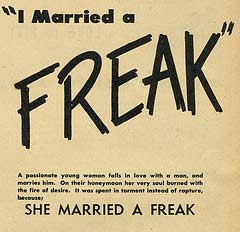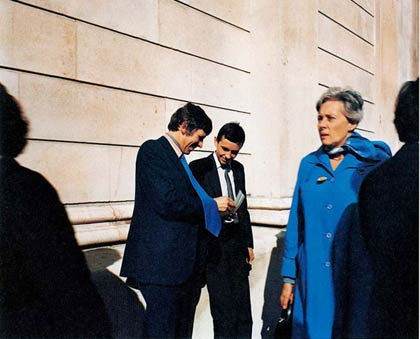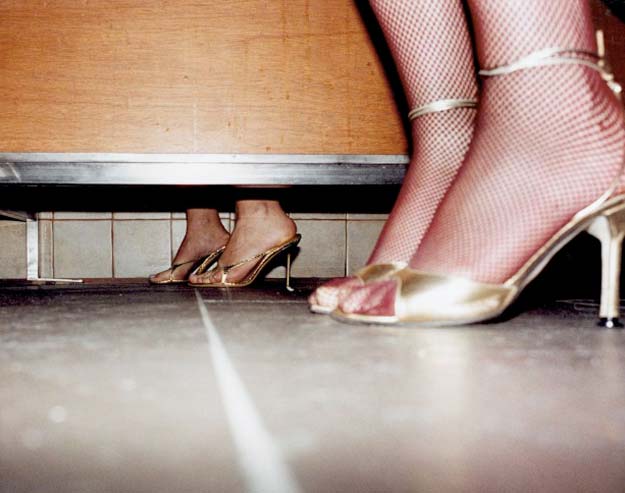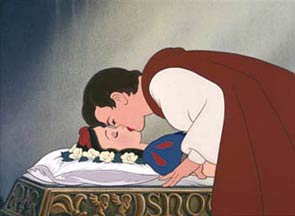
In the same way that people do not always leave 15% of their bill as a tip (even though this is the norm) but rather adjust it up or down as a function of other factors (e.g., service quality), one would expect that the price paid for an engagement ring might too be linked to several extraneous variables.
Lee Cronk and Bria Dunham published a paper recently in Human Nature wherein they sought to explore this exact issue. They sent out a short survey to 1,000 married couples and asked several questions including the income and age of each member of the couple, as well as how much was spent on the engagement ring. (…)
They found that both men’s and women’s incomes were positively correlated to the amount spent on an engagement ring. (…). Furthermore, the authors uncovered a negative correlation between the amount spent on a ring and the bride’s age. In other words, the younger the bride, the larger the expenditure.
{ PsychologyToday | Continue reading }
illustration { Kristian Hammerstad }
economics, relationships | November 19th, 2009 6:24 pm

Why do women eat salads on dates? A new study suggests it’s all for show.
Researchers at McMaster University in Hamilton, Ontario, Canada, observed 469 individuals in 266 groups at three cafeterias on campus. Sitting at a distance of at least 10 meters (damn Canadians and their metric system), the researchers watched these people in a natural setting and recorded how many people were sitting at each table, of what gender the people were, and estimated the caloric content of what each one was eating.
The findings were pretty clear:
1) Females chose foods with significantly fewer calories when eating with men rather than women. (Note to Jezebel: word “female” is in the study!)
2) Women’s food choices weren’t affected just by a man being present, but in proportion to how many men were present — more men equaled fewer calories.
{ True/Slant | Continue reading }
food, drinks, restaurants, health, relationships | November 13th, 2009 9:37 am

“I actually think that woman has a point,” said the first to reply. “Most guys are emotionally retarded, especially in their youth. So telling a guy you love him before he has figured out what’s going on in his own head does carry some risk.”
{ Salon | Continue reading }
guide, relationships | November 13th, 2009 9:35 am
books, relationships | November 7th, 2009 5:00 pm

What’s the gossip in your office? What’s the gossip doing to your office? And what are the best strategies for gossips or antigossips to employ in the office? (…)
Timothy Hallett, a sociologist at Indiana University, spent two years studying the institutional politics at an elementary school in a Midwestern city. During that time, Dr. Hallett videotaped formal meetings among a group of teachers who convened regularly to discuss problems and policies.
The teachers would occasionally start to deviate from the official agenda and discuss their feelings about the administrators, particularly the principal, who was disliked for her style and her effort to impose more “accountability” on the teachers. These “gossip episodes” are analyzed by Dr. Hallett and his co-authors. (…) “Gossip was a ‘weapon of the weak’: during a time in which teachers were disenfranchised, gossip empowered them and served to stigmatize Kox.”
{ TierneyLab/NY Times | Continue reading }
“Office gossip can be a form of reputational warfare,” Dr. Hallett says. “It’s like informal gossip, but it’s richer and more elaborate. There are more layers to it because people practice indirectness and avoidance. People are more cautious because they know they can lose not just a friendship but a job.”
During his two years studying the group dynamics at a Midwestern elementary school, which allowed him access on condition of anonymity, Dr. Hallett found that the teachers became so comfortable with him and his camera that they would freely insult their bosses during one-on-one interviews. But at the teachers’ formal group meetings, where they knew that another teacher might report their insults to the principal, they were more discreet.
Instead of making direct criticisms, they sometimes offered obliquely sarcastic comments to test the waters. They used another indirect tactic categorized as praise the predecessor, as in the meeting when a teacher fondly recalled a previous administration: “It was so calm, and you could teach. No one was constantly looking over your shoulder.” The other teachers quickly agreed. No one explicitly called the current principal an authoritarian busybody, but that was the obvious implication.
{ NY Times | Continue reading }
photo { Paul Graham }
relationships, science | November 7th, 2009 3:21 pm

How do we fall in love? There are countless times during the course of the day when someone catches your eye. I remember recently being in [a coffee bar] across from my editor’s apartment (…) and there was a fine-boned woman behind the cash register with a neck like an antelope, and we looked at one another in that appraising and mutually approving way that, had I been a single man rather than a very happily married one (more on love, lies and marriage to come in a later column), would have resulted in a conversation. That is, we provoke and are provoked by one another frequently, perhaps many times a day. If our sexual antennae are up—in New York, when I visit, as opposed to Kansas City, where I live, the array and intertwining of sexual antennae seems like a tangle of erotic interest, a dangerous sensual spider web—we could begin the process of feeling one another out (which would lead, one hopes, to feeling one another up) in an almost daily way. (…)
According to Aristophanes, human beings were once joined together in pairs, so that we had four arms and four legs. But this unusual metrical composition and arrangement of limbs made us so speedy—have you ever noticed how everything accelerates when you’re in love, except the time apart from your lover?—that we dared to roll our way up Mount Olympus, challenging the Gods, which prompted Zeus, quite sensibly, to split us apart with thunderbolts (the stitching up of skin he had to do afterwards was pulled together at one point, which is why you have a belly button). But this splitting in two—whether woman from woman, man from man, or man from woman (there were all three sorts)–is why, now, you feel this desperate need to be reunited with your other half, it is why you no longer feel whole, except when you are in love. True love, then—and this is where all this trouble starts, which is later exploited by so many poets and brokenhearted cowboy singers—is when you are reunited with that single person who was once your other half.
{ Clancy Martin/The Faster Times | Continue reading }
ideas, relationships | November 7th, 2009 3:18 pm

Why do people say “um” and “er” when hesitating in their speech?
This question can actually be split into two: why do people say anything at all while hesitating and why do they say “er” and “um” instead of other possible sounds?
To answer the first question, linguists known as conversation analysts have observed that people vocalise in a conversation when they think it is their turn to talk, and there are several ways of negotiating the taking of those turns. One of them is the relinquishing of a turn by the current speaker and another speaker taking the floor. Therefore, silence is often construed as a signal that the current speaker is ready to give up his or her turn.
So, if we wish to continue our speaking turn, we often need to fill the silences with a sound to show that we intend to carry on speaking. If we always thought out thoroughly everything we were going to say in a conversation, or memorised our lines perfectly there would be no hesitation at all. But, as it is, we do a lot of what is called local management, or improvisation, during conversation for many reasons not least because we cannot predict the reactions of our interlocutor. In order to keep the floor while we hesitate, we place dummy words in the empty spaces between our words, much as we might drape our coats on a seat at the cinema to prevent others from taking it.
The second question, as to why “er” and “um” are used instead of say, “ee” or “choo” is not as easy to answer.
“Er”, in British English, is a transcription of the phonetic schwa sound found in unstressed syllables of English words (such as the vowel sound in the first syllable of “potato”). In traditional phonetics this was called the neutral sound because it is the vowel sound produced when the mouth is not in gear, that is, not tensed to say any of the other formed vowels such as “e”. The “um” sound is more difficult to explain unless it is just a bad transcription of the same neutral sound with a consonant that closes the mouth in preparation for another real word.
{ NewScientist }
artwork { Kitagawa Utamaro }
archives, ideas, relationships, science | October 30th, 2009 9:00 am

Frankenhooker, an American film released in 1990.
Plot: When his gorgeous fiancée “goes to pieces” in a freak lawnmower accident, aspiring mad scientist Jeffrey Franken is determined to put her back together again. With the aid of an explosive superdrug, he sets about reassembling his girlfriend, selecting the choicest bits from a bevy of raunchy New York prostitutes. But his bizarre plan soon goes awry. His reanimated girlfriend no longer craves his body… she craves everybody! And, for money, she’ll love anyone… to death!
{ Wikipedia | Watch the trailer }
haha, relationships, showbiz | October 17th, 2009 4:40 pm

Ida Irene Dalser (1880–1937) was the first wife of Italian fascist dictator Benito Mussolini (1883–1945).
They got married in 1914 and in 1915 she bore him his first child, Benito Albino Mussolini, whom Mussolini legally recognised as his son.
However, in 1910, Rachele Guidi moved in with Benito Mussolini, and on 17 December 1915, Rachele Guidi and Benito Mussolini married in a civil ceremony in Lombardy. When this became known to Ida Dalser, a legal dispute began between her and the new couple.
Once Mussolini was in power, Ida Dalser and her son were placed under surveillance by the police, and paper evidence of their relationship was tracked down to be destroyed by government agents. She still persisted in claiming her role as the dictator’s wife, and even publicly denounced Mussolini as a traitor. Eventually, she was forcibly interned in the psychiatric hospital of Pergine Valsugana, and then transferred to that of the island of San Clemente in Venice, where she died in 1937. The cause of death was registered as “brain haemorrhage.”
Rachele Mussolini remained loyal to Mussolini until the end, and ignored his various mistresses. But, on 28 April 1945, she was not with Mussolini when he and his mistress, Claretta Petacci, were captured and executed by Italian partisans.
On 28 April, Claretta Petacci (1912–1945) and Mussolini were taken to Mezzegra where they were shot. On the following day, their bodies were taken to the Piazzale Loreto in Milan and hung upside down on meat hooks in front of an Esso petrol station. The bodies were photographed as a crowd vented their rage upon them.
photo { A giant M installed to greet Mussolini’s arrival in a small Piemonte village (Italy, 1938) | photo: Farabola/LEEMAGE | Enlarge }
related { Benito Mussolini: British Secret Agent }
flashback, relationships | October 17th, 2009 4:00 am

1) Throughout human history social activities have taken place at night. (In fact more than 60 percent of the people Piffer polled met their latest partner in the evening or night.) The evening is commonly reserved for courtship activity — dancing, drinking, having sex. Over time, the male night owl attends more social events, meets more women, and has more sex.
2) “Eveningness” is a sexually dimorphic trait. Across cultures, “more males than females stay up late at night (due to biological differences involving the timing of peak melatonin levels). Piffer speculates that men evolved to stay up late because the most reproductively successful men pass along their genes to subsequent generations. In terms of Darwinian sexual selection, evening orientation benefits males more because it gives them an increased opportunity to acquire multiple lovers — all at one go, or over time. Women, however, don’t achieve greater reproductive success by having sex with more men (it only takes one to get pregnant), which is why fewer women are evening-oriented. Men with an evening orientation have a competitive advantage over men with a morning orientation.
3) Evening-orientation, Piffer speculates, may also be a direct product of sexual selection. That is, women may actively choose night owls over morning birds. Piffer draws on the “cads-versus-dads” theory; that is, women often go for bad boys, especially at a certain stage of life, and men who stay up into the night are likelier to fall into this category.
4) Being a night owl may also be a form of “handicap signaling.” Staying up late at night (possibly drinking and smoking) can take a toll on one’s health. Only a man who is fit and healthy would be able to compensate for his lifestyle. Assuming a man seems unaffected by little sleep, his evening orientation indicates a strong constitution — a sexy quality.
{ Jena Pincott | Continue reading | Continue reading | Circadian Preference and Sexual Selection: A Novel Evolutionary Approach, by Davide Piffer }
photo { Jessica Craig-Martin }
archives, psychology, relationships, science | October 2nd, 2009 10:34 pm











